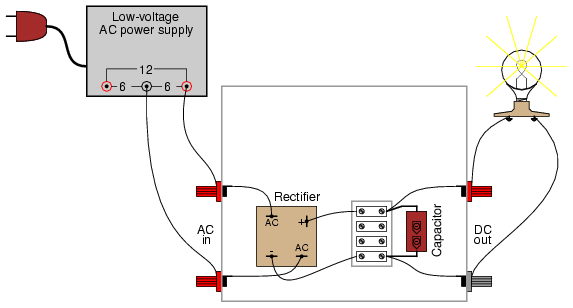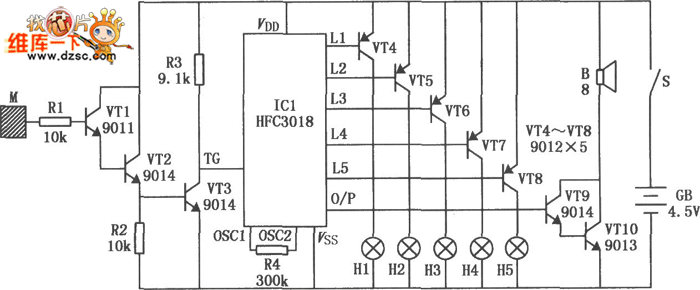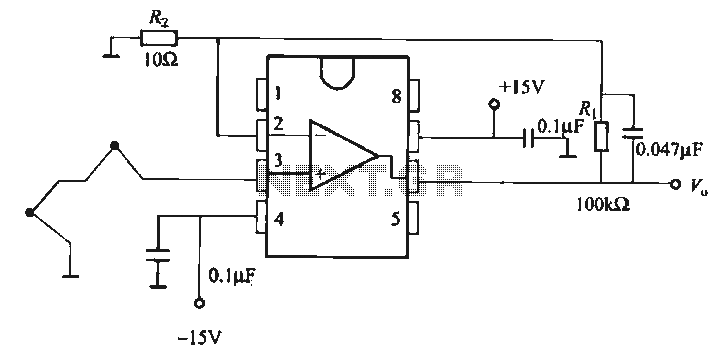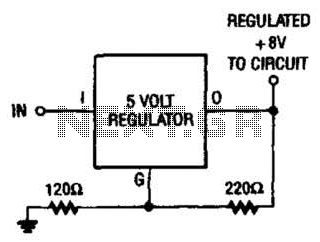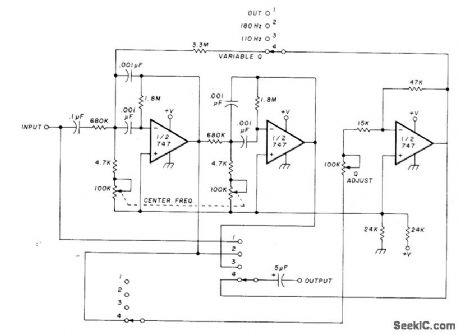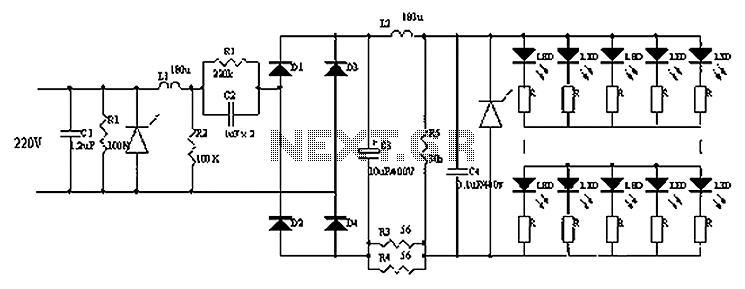
Automatic Street Light Controller Circuit
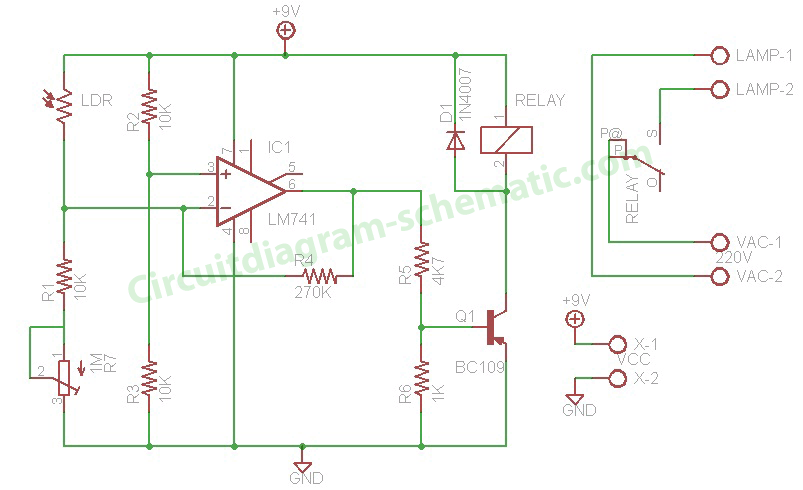
This circuit is an automatic street light controller. The sensor used to detect changes in light is an LDR (Light Dependent Resistor). The working principle of the LDR is that when exposed to light, its resistance value decreases, while in darkness, its resistance increases. In dark conditions, the resistance value of the LDR is high, allowing a small electric current to pass. This occurs because the non-inverting reference voltage is greater than the inverting input voltage. Consequently, the output of the LM741 operational amplifier is high, turning the transistor ON, which in turn activates the relay, thus turning the light ON. Conversely, in light conditions, when the LDR's resistance is low, a larger electric current flows. This is due to the inverting input voltage being greater than the non-inverting reference voltage, resulting in the LM741 output being low, turning the transistor OFF, and deactivating the relay, which turns the lights OFF. The circuit is designed to operate an AC lamp rated at 220V and 20 watts. A 9V battery supplies the circuit's voltage. The LDR must be positioned where it can directly sense the ambient light. A PCB (Printed Circuit Board) layout for the automatic street light controller is also included and available for download.
This automatic street light controller circuit utilizes an LDR to regulate lighting based on ambient light levels. The LDR is a crucial component; its resistance varies significantly depending on the light intensity. In darkness, the high resistance of the LDR allows a small current to flow, which is sensed by the LM741 operational amplifier. The LM741 is configured in a comparator mode, where it compares the voltage across the LDR (connected to the inverting input) with a reference voltage (connected to the non-inverting input). When the light level is low, the output of the LM741 is driven high, activating the transistor switch.
The transistor serves as a relay driver, providing sufficient current to energize the relay coil. When the relay is energized, it closes its contacts, allowing current to flow to the AC lamp, thus illuminating the area. Conversely, when sufficient light is detected, the resistance of the LDR decreases, resulting in a higher voltage at the inverting input compared to the non-inverting input. This causes the output of the LM741 to drop, turning the transistor OFF and deactivating the relay, which in turn cuts off power to the lamp.
The circuit is powered by a 9V battery, ensuring that it can operate independently of mains power. The design should include protection mechanisms such as a diode across the relay coil to prevent back EMF from damaging the transistor when the relay is turned OFF. The PCB layout should be designed to minimize noise and ensure reliable operation, with clear traces for the high-power AC connections and appropriate spacing to prevent arcing. The overall design is efficient and effective for automatic street lighting applications, ensuring lights are only on when needed, thereby conserving energy.This circuit is an automatic street light controller. Sensors used to detect changes in light is LDR (Light dependent resistor), the working principle of Light dependent resistor is exposed to light when the resistance value of LDR great, but if not exposed to light or dark then the resistance value of LDR. This circuit when the dark conditions (n ight) or the resistance value of LDR, a small electric current is passing, because the non-inverting reference voltage is greater than the inverting input voltage. So that the LM741 IC output value 1 ³, the transistor switches in the ON condition, the relay is also in the ON condition, so that the light is on.
Here is a schematic drawing of automatic street light controller: When light conditions (daylight) or LDR resistance value is small, a large electric current is passing. This is due to the inverting input voltage is greater than the non-inverting reference voltage, the LM741 IC output value 0 ³, the transistor in the OFF condition, the relay is also in the OFF state, so the lights went out.
To light using AC Lamp 220V 20watt. To source voltage of this circuit using a battery 9Volt. LDR (Light dependent resistor) should be placed on the affected light directly. here I also include a PCB (printed circuit board) of the automatic street light controller and you can also download it. 🔗 External reference
This automatic street light controller circuit utilizes an LDR to regulate lighting based on ambient light levels. The LDR is a crucial component; its resistance varies significantly depending on the light intensity. In darkness, the high resistance of the LDR allows a small current to flow, which is sensed by the LM741 operational amplifier. The LM741 is configured in a comparator mode, where it compares the voltage across the LDR (connected to the inverting input) with a reference voltage (connected to the non-inverting input). When the light level is low, the output of the LM741 is driven high, activating the transistor switch.
The transistor serves as a relay driver, providing sufficient current to energize the relay coil. When the relay is energized, it closes its contacts, allowing current to flow to the AC lamp, thus illuminating the area. Conversely, when sufficient light is detected, the resistance of the LDR decreases, resulting in a higher voltage at the inverting input compared to the non-inverting input. This causes the output of the LM741 to drop, turning the transistor OFF and deactivating the relay, which in turn cuts off power to the lamp.
The circuit is powered by a 9V battery, ensuring that it can operate independently of mains power. The design should include protection mechanisms such as a diode across the relay coil to prevent back EMF from damaging the transistor when the relay is turned OFF. The PCB layout should be designed to minimize noise and ensure reliable operation, with clear traces for the high-power AC connections and appropriate spacing to prevent arcing. The overall design is efficient and effective for automatic street lighting applications, ensuring lights are only on when needed, thereby conserving energy.This circuit is an automatic street light controller. Sensors used to detect changes in light is LDR (Light dependent resistor), the working principle of Light dependent resistor is exposed to light when the resistance value of LDR great, but if not exposed to light or dark then the resistance value of LDR. This circuit when the dark conditions (n ight) or the resistance value of LDR, a small electric current is passing, because the non-inverting reference voltage is greater than the inverting input voltage. So that the LM741 IC output value 1 ³, the transistor switches in the ON condition, the relay is also in the ON condition, so that the light is on.
Here is a schematic drawing of automatic street light controller: When light conditions (daylight) or LDR resistance value is small, a large electric current is passing. This is due to the inverting input voltage is greater than the non-inverting reference voltage, the LM741 IC output value 0 ³, the transistor in the OFF condition, the relay is also in the OFF state, so the lights went out.
To light using AC Lamp 220V 20watt. To source voltage of this circuit using a battery 9Volt. LDR (Light dependent resistor) should be placed on the affected light directly. here I also include a PCB (printed circuit board) of the automatic street light controller and you can also download it. 🔗 External reference
